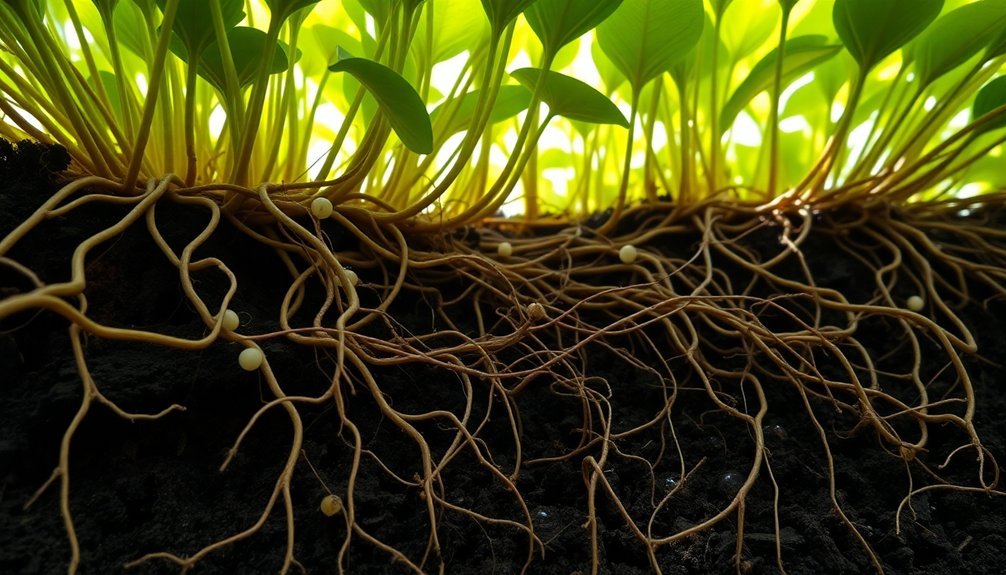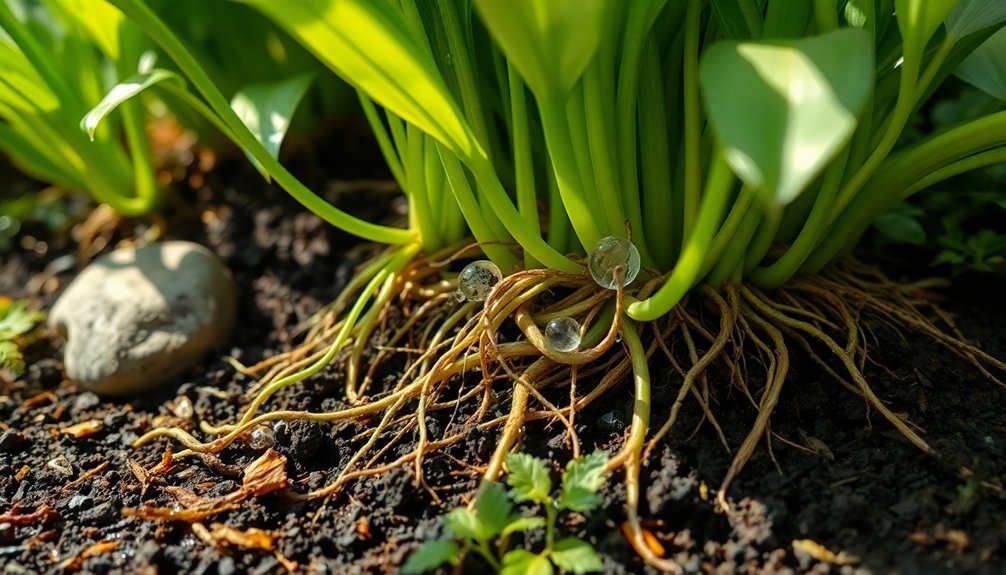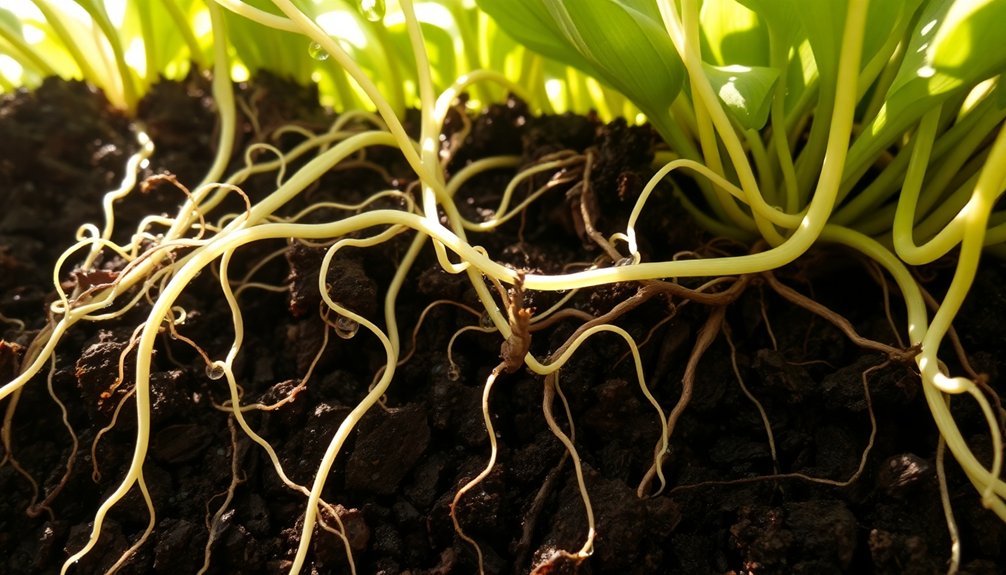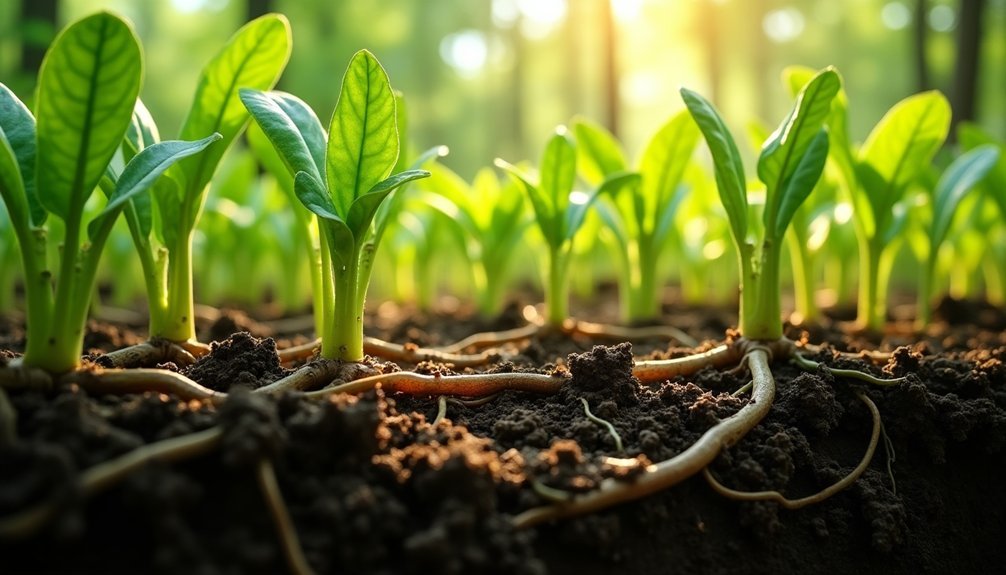Air-purifying plants develop specialized root systems that enhance their ability to filter indoor pollutants. You'll find fibrous roots in most species, while some like Spider Plants and Pothos develop aerial roots to extract moisture from the air. These plants thrive when you maintain soil temperatures between 65-75°F and provide well-draining soil. Their root networks act as nutrient highways, channeling essential minerals throughout the plant. Understanding these root patterns will reveal your plants' full purification potential.
Understanding Root Systems in Air-Purifying Plants

While many people focus on the visible parts of air-purifying plants, their root systems play a crucial role in their ability to clean indoor air. You'll find that most of these plants have fibrous roots, which excel at absorbing water and nutrients, enabling them to perform their air-cleaning functions effectively.
Some air purifiers, like Spider Plants and Pothos, develop specialized aerial roots that can extract moisture directly from the atmosphere, particularly when humidity levels are high.
The Peace Lily's root structure supports transpiration, which helps filter pollutants from your indoor air. If you're working with limited space, you'll appreciate plants like the Snake Plant, whose shallow root system thrives in smaller containers without compromising its air-purifying capabilities.
Understanding these root patterns will help you provide better care and maintain your plants' air-cleaning effectiveness.
Key Growth Stages of Plant Root Development
When you're growing air-purifying plants, understanding the key stages of root development can make a significant difference in their success.
The process begins with root hair formation, which expands the surface area needed for absorbing water and nutrients. You'll then see roots enter their elongation phase, where they grow longer and search through the soil for essential resources.
Next, you'll notice lateral roots branching out to create an extensive network that strengthens the plant's stability and enhances its ability to absorb pollutants.
Within 2 to 4 weeks, you can expect healthy roots to develop under proper care conditions.
Remember that root depth and spread are vital – deeper roots can access moisture from lower soil layers, helping your air-purifying plants thrive in various environmental conditions.
Environmental Factors Affecting Root Formation

Because successful root formation depends heavily on environmental conditions, understanding these factors can greatly improve your air-purifying plants' health.
You'll find that maintaining temperatures between 65°F to 75°F creates the perfect environment for robust root development, while proper moisture levels keep roots healthy without risking rot.
For maximum root growth, verify you're providing:
- Adequate indirect sunlight, which strengthens the root system and supports overall plant health
- Well-balanced fertilizer that delivers essential minerals for sustained root development
- Good air circulation around the root zone to prevent fungal issues and support root respiration
When you maintain these conditions consistently, you'll create an ideal environment where your air-purifying plants can develop strong, healthy root systems that effectively support their growth and air-cleaning capabilities.
Nutrient Absorption Through Root Networks
The intricate root networks of air-purifying plants serve as sophisticated nutrient highways, channeling essential minerals from soil to stem.
You'll find these roots actively extracting crucial elements like nitrogen, phosphorus, and potassium, which support both plant health and air-cleaning capabilities.
When your plant develops deeper roots, it's able to access nutrients from a larger soil volume, making it more effective at purifying your air.
The roots don't work alone – they partner with beneficial soil microorganisms that break down organic matter, making nutrients more readily available for absorption.
You'll get the best results when you provide well-aerated, nutrient-rich soil for your air-purifying plants.
This environment encourages vigorous root growth, which directly impacts how effectively your plants can improve indoor air quality.
Water Requirements for Optimal Root Health

While nutrient-rich soil provides the foundation for healthy roots, proper watering practices determine their long-term importance.
You'll need to monitor soil moisture consistently, allowing the top inch to dry between waterings to prevent root rot while maintaining adequate hydration for effective air purification.
Your air-purifying plants will thrive when you follow these essential watering guidelines:
- Use well-draining soil to prevent water pooling around roots
- Adjust watering frequency based on seasons – more during growth months, less in cooler periods
- Match water levels to specific plant needs – Snake Plants prefer drier conditions, while Boston Ferns need consistent moisture
Watch for warning signs like yellowing leaves or wilting, as they'll indicate whether you're overwatering or underwatering your plants.
These symptoms directly impact both root health and air-cleaning efficiency.
Common Root Growth Patterns Among Species
You'll notice that different air-purifying plants show distinct root growth patterns based on their exposure to light, with plants like Golden Pothos developing more extensive root systems in brighter conditions.
The seasonal changes affect root development rates, as most species exhibit accelerated growth during spring and summer months while slowing down in fall and winter.
When you compare various species, you'll find that shallow-rooted plants like Peace Lilies contrast sharply with the robust, thick roots of Rubber Plants, though both effectively support their air-purifying functions.
Root Development by Light
Understanding light's impact on root development reveals fascinating patterns across air-purifying plant species.
You'll notice that plants receiving brighter light develop deeper, more robust root systems to support their growing foliage.
- In well-lit areas, plants like Pothos will establish extensive, fibrous roots that spread throughout the soil, allowing them to efficiently gather nutrients.
- When you place Rubber Plants in varying light conditions, they'll adapt their root growth strategically to find moisture and nutrients.
- If you're growing Peace Lilies in low-light spots, they'll develop shallower roots, focusing on moisture retention near the soil's surface.
This knowledge directly impacts your watering routine – plants with deeper roots in bright light need less frequent watering than their shallow-rooted counterparts in dimmer conditions.
Seasonal Growth Rate Patterns
As seasons shift throughout the year, air-purifying plants display distinct patterns in their root development.
You'll notice most species, including Peace Lilies and Spider Plants, experience their peak root growth during warmer months when they benefit from increased light and warmth.
Your Rubber Plant will likely show impressive root development in spring and summer, taking advantage of longer daylight hours and higher humidity.
However, don't be concerned if your Snake Plant's roots grow more slowly during cooler months – they're simply conserving energy in their dormant phase.
While Boston Ferns maintain steady root growth year-round thanks to their preference for consistent humidity, you'll find that adaptable plants like Golden Pothos adjust their root development based on available light, thriving across various seasonal conditions.
Cross-Species Root Comparisons
Despite their diverse origins, air-purifying plants share several distinctive root patterns that enhance their ability to clean indoor air.
You'll notice that species like Snake Plants and Pothos develop fibrous systems for efficient nutrient absorption, while Rubber Plants and Peace Lilies form thicker roots for water storage.
Here's what you'll find when comparing these plants' root structures:
- Spider Plants create horizontal networks of shallow roots through their pups, maximizing soil coverage.
- Monstera Deliciosa develops unique aerial roots that pull moisture directly from the atmosphere.
- Boston Ferns establish dense root systems that excel at moisture retention and plant anchoring.
These varied root adaptations show how different species have evolved to optimize their growth and air-purifying capabilities while thriving in their preferred environments.
Root System Maintenance and Care Tips
When pruning your air-purifying plant's roots, trim away any black, mushy, or obviously dead sections while leaving healthy white roots intact to support continued growth.
You'll need to maintain proper water quality by using room-temperature, filtered water that's free from chlorine and harmful minerals that could damage the root system.
Regular maintenance of both roots and water quality will strengthen your plant's foundation, leading to better air-purifying performance and overall health.
Root Pruning Best Practices
Root pruning plays a fundamental role in maintaining healthy air-purifying plants by preventing root-bound conditions and promoting ideal growth.
You'll need to use clean, sharp tools to make precise cuts and minimize stress on your plant's root system.
To guarantee successful root pruning, follow these essential steps:
- Time your pruning during the active growing season (spring or early summer) when your plant can recover quickly.
- Reduce the root mass by 1/3 to 1/2 when repotting to create space for new growth.
- Make clean cuts with sterile tools to prevent infection and encourage healthy regeneration.
Remember to regularly check your plant's root health for signs of rot or overcrowding.
These issues can greatly impact your plant's air-purifying abilities and overall health.
Water Quality For Roots
Three key aspects of water quality directly impact the health of your air-purifying plants' root systems. You'll need to verify you're using chlorine-free water, maintaining proper temperature, and changing the water regularly to prevent stagnation.
| Water Factor | Ideal Condition | Impact on Roots |
|---|---|---|
| Type | Filtered/Distilled | Prevents root damage |
| Temperature | 65-75°F (18-24°C) | Promotes growth |
| Change Frequency | Every few days | Prevents rot |
Using clear containers helps you monitor root development and catch potential issues early. You'll want to keep roots submerged but not waterlogged to maintain proper oxygen levels. Watch for yellowing leaves, which often signal poor light conditions affecting root health. Remember that clean water creates the foundation for healthy root growth in your air-purifying plants.
Frequently Asked Questions
What Plant Removes 78% of Airborne Mold?
You'll want to get a Peace Lily for your space, as it's incredibly effective at removing 78% of airborne mold spores. It's an excellent air purifier that'll thrive even in low-light conditions.
How Do Air-Purifying Plants Work?
Your air-purifying plants work by absorbing toxins and CO2 through their leaves and roots. They'll convert these pollutants during photosynthesis, releasing clean oxygen while their roots help filter harmful substances.
How Does Air Influence Plant Growth?
You'll find that air directly affects your plants' growth through photosynthesis, root development, and transpiration. Clean air with proper CO2 levels and humidity helps your plants thrive while preventing root diseases.
Which Plant Purifies Air the Most?
You'll find the Peace Lily ranks as the most effective air purifier among common houseplants. It's proven to remove multiple toxins like ammonia, xylene, and toluene, making it your best choice for cleaner air.
In Summary
You'll find that healthy roots are the foundation of thriving air-purifying plants. By understanding root patterns, growth stages, and environmental needs, you're better equipped to care for these natural air cleaners. Remember to monitor water levels, guarantee proper nutrients, and maintain ideal growing conditions. When you focus on root health, you'll enjoy more vigorous plants and cleaner indoor air.





Leave a Reply